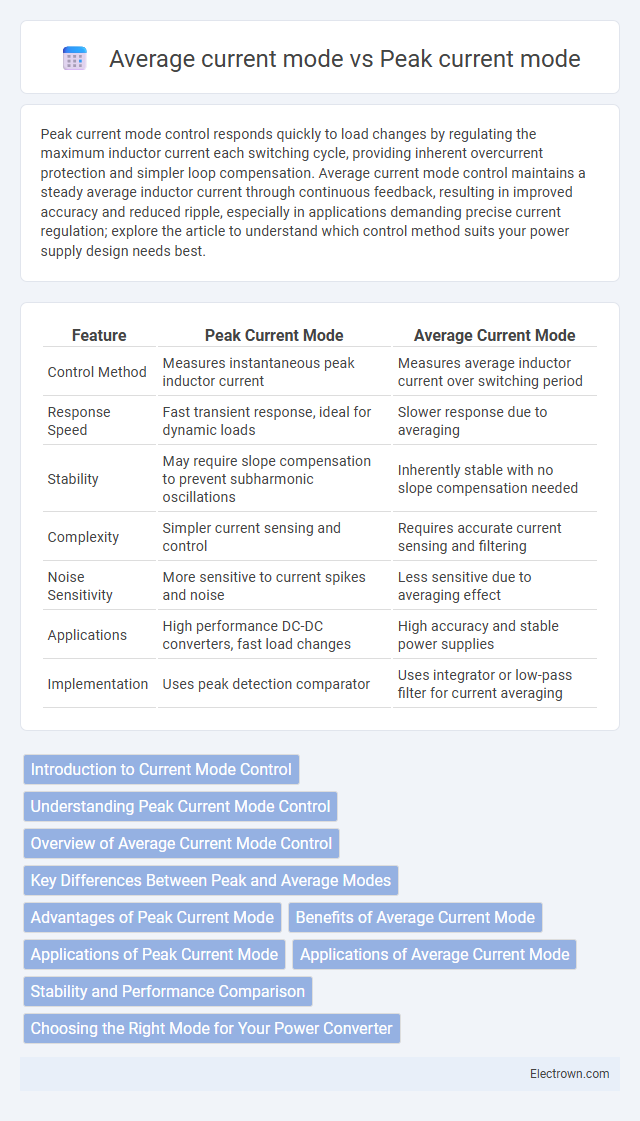Peak current mode control responds quickly to load changes by regulating the maximum inductor current each switching cycle, providing inherent overcurrent protection and simpler loop compensation. Average current mode control maintains a steady average inductor current through continuous feedback, resulting in improved accuracy and reduced ripple, especially in applications demanding precise current regulation; explore the article to understand which control method suits your power supply design needs best.
Table of Comparison
| Feature | Peak Current Mode | Average Current Mode |
|---|---|---|
| Control Method | Measures instantaneous peak inductor current | Measures average inductor current over switching period |
| Response Speed | Fast transient response, ideal for dynamic loads | Slower response due to averaging |
| Stability | May require slope compensation to prevent subharmonic oscillations | Inherently stable with no slope compensation needed |
| Complexity | Simpler current sensing and control | Requires accurate current sensing and filtering |
| Noise Sensitivity | More sensitive to current spikes and noise | Less sensitive due to averaging effect |
| Applications | High performance DC-DC converters, fast load changes | High accuracy and stable power supplies |
| Implementation | Uses peak detection comparator | Uses integrator or low-pass filter for current averaging |
Introduction to Current Mode Control
Current mode control regulates power converters by directly controlling the inductor current, improving response to load changes and enhancing stability. Peak current mode control measures the instantaneous peak inductor current each switching cycle, offering fast over-current protection and simplified loop compensation. Average current mode control monitors the average inductor current over a switching period, providing smoother current regulation and reduced ripple for your power supply design.
Understanding Peak Current Mode Control
Peak current mode control regulates the switch current by directly monitoring and limiting the inductor current during each switching cycle, offering faster response to load changes and inherent overcurrent protection. This method simplifies loop compensation by effectively creating a single-pole system, improving stability and transient response compared to average current mode control, which relies on integrating current over time. Understanding peak current mode helps optimize your power converter design for efficiency and precise current regulation in dynamic load conditions.
Overview of Average Current Mode Control
Average current mode control regulates the inductor current by comparing the measured average current to a reference, ensuring precise and stable load regulation in power converters. This method reduces current ripple and improves transient response by modulating the duty cycle based on the average inductor current rather than instantaneous peak values. Commonly used in DC-DC converters, average current mode control enhances efficiency and minimizes electromagnetic interference (EMI) in switching power supplies.
Key Differences Between Peak and Average Modes
Peak current mode control measures the instantaneous peak current in each switching cycle to regulate power, providing faster response and inherent overcurrent protection. Average current mode control monitors the average current over a switching period, resulting in smoother output and better stability under varying load conditions. Understanding these differences helps you select the appropriate mode for applications requiring either rapid transient response or precise current regulation.
Advantages of Peak Current Mode
Peak current mode control offers faster response to load changes and improved system stability by directly regulating the peak inductor current, leading to enhanced transient performance. It simplifies the current loop compensation, reducing design complexity and improving noise immunity. Your power supply can achieve better overcurrent protection and more precise current limiting with this control method.
Benefits of Average Current Mode
Average current mode control offers enhanced stability and improved transient response in power converters by continuously monitoring and regulating the inductor current over an entire switching cycle. It reduces current ripple and minimizes electromagnetic interference (EMI), leading to higher efficiency and better performance in applications such as DC-DC converters and power supplies. This control mode simplifies the design of compensators, making it ideal for systems requiring precise current regulation and robust load handling.
Applications of Peak Current Mode
Peak current mode control is widely used in switch-mode power supplies and DC-DC converters due to its fast response and inherent overcurrent protection. This mode is ideal for applications requiring precise current limiting, such as battery charging and LED drivers, where rapid adjustment of the inductor current improves efficiency and stability. Your choice of peak current mode ensures better handling of transient loads and simplified control loop compensation compared to average current mode.
Applications of Average Current Mode
Average current mode control is widely used in power supplies and battery charging systems due to its ability to provide precise current regulation and enhance system stability. This control method is ideal for applications requiring accurate current monitoring, such as LED drivers, telecommunications power systems, and solar inverters. Its inherent advantages in noise immunity and response to load changes make it suitable for sensitive and high-performance electronic devices.
Stability and Performance Comparison
Peak current mode control offers superior stability due to its inherent inner current loop that provides fast response and reduces subharmonic oscillations, making it ideal for converters operating at high switching frequencies. Average current mode control enhances performance by delivering more accurate current regulation and better noise immunity, which improves overall output voltage precision and dynamic response in complex load conditions. Stability in peak current mode can degrade without slope compensation at duty cycles above 50%, whereas average current mode maintains consistent stability across operating ranges but requires more complex compensation networks.
Choosing the Right Mode for Your Power Converter
Choosing the right current mode for your power converter depends on factors like response speed, stability, and complexity. Peak current mode control offers faster transient response and built-in overcurrent protection, making it suitable for converters with wide input voltage ranges or varying loads. Average current mode control provides improved steady-state accuracy and lower output ripple, ideal for applications requiring precise current regulation and minimal electromagnetic interference.
Peak current mode vs Average current mode Infographic

 electrown.com
electrown.com